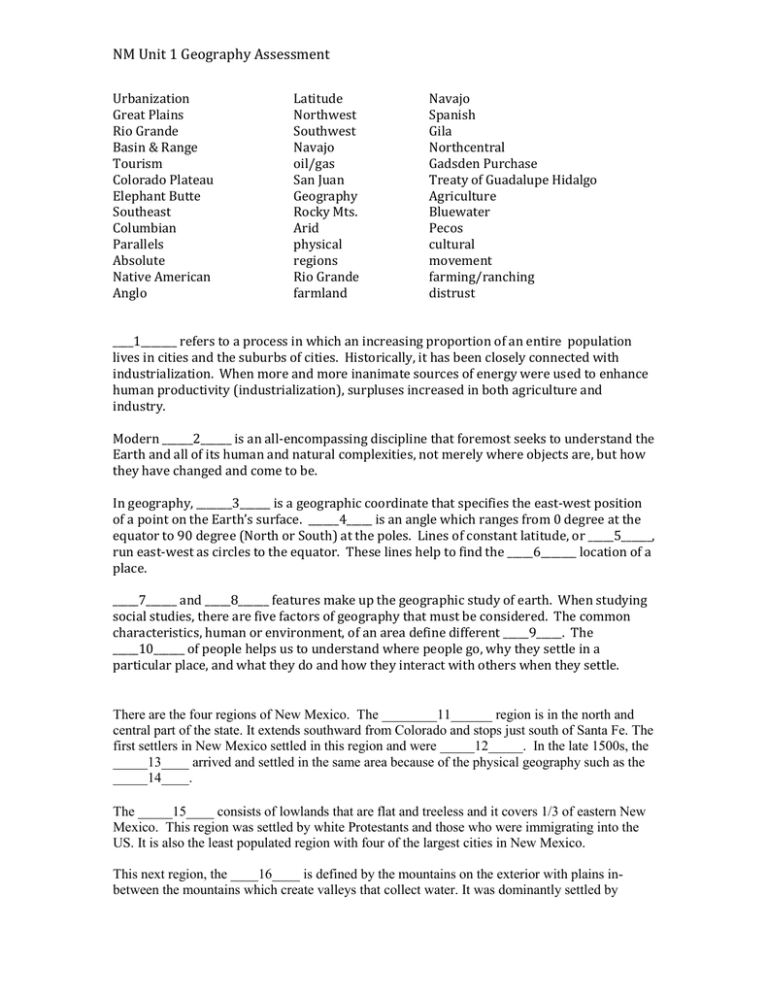NM Unit 1 Geography Assessment
advertisement

NM Unit 1 Geography Assessment Urbanization Great Plains Rio Grande Basin & Range Tourism Colorado Plateau Elephant Butte Southeast Columbian Parallels Absolute Native American Anglo Latitude Northwest Southwest Navajo oil/gas San Juan Geography Rocky Mts. Arid physical regions Rio Grande farmland Navajo Spanish Gila Northcentral Gadsden Purchase Treaty of Guadalupe Hidalgo Agriculture Bluewater Pecos cultural movement farming/ranching distrust ____1_______ refers to a process in which an increasing proportion of an entire population lives in cities and the suburbs of cities. Historically, it has been closely connected with industrialization. When more and more inanimate sources of energy were used to enhance human productivity (industrialization), surpluses increased in both agriculture and industry. Modern ______2______ is an all-encompassing discipline that foremost seeks to understand the Earth and all of its human and natural complexities, not merely where objects are, but how they have changed and come to be. In geography, _______3______ is a geographic coordinate that specifies the east-west position of a point on the Earth’s surface. ______4_____ is an angle which ranges from 0 degree at the equator to 90 degree (North or South) at the poles. Lines of constant latitude, or _____5______, run east-west as circles to the equator. These lines help to find the _____6_______ location of a place. _____7______ and _____8______ features make up the geographic study of earth. When studying social studies, there are five factors of geography that must be considered. The common characteristics, human or environment, of an area define different _____9_____. The _____10______ of people helps us to understand where people go, why they settle in a particular place, and what they do and how they interact with others when they settle. There are the four regions of New Mexico. The ________11______ region is in the north and central part of the state. It extends southward from Colorado and stops just south of Santa Fe. The first settlers in New Mexico settled in this region and were _____12_____. In the late 1500s, the _____13____ arrived and settled in the same area because of the physical geography such as the _____14____. The _____15____ consists of lowlands that are flat and treeless and it covers 1/3 of eastern New Mexico. This region was settled by white Protestants and those who were immigrating into the US. It is also the least populated region with four of the largest cities in New Mexico. This next region, the ____16____ is defined by the mountains on the exterior with plains inbetween the mountains which create valleys that collect water. It was dominantly settled by NM Unit 1 Geography Assessment Hispanics and is the largest region in New Mexico. Because of the fertility of land and water, the majority of New Mexico’s ____17____ industry is in this region. The ____18____ is made up of elevated tablelands or mesas formed by lava flows, and erosion. The region extends across the ____19_____ part of the state and is place of settlement for the largest ____20____ reservation. The ____21____ industry is one of the largest economic sources of this region. New Mexico has an ____22___ climate and rivers are extremely important they supply water to plants, animals, and people. There are six major rivers: San Juan, Chama, Canadian, Rio Grande, Pecos, and the Gila that have helped to determine the settlement patterns in New Mexico because of the need for access to water. Some of New Mexico’s lakes include: Navajo, Heron, Elephant Butte, Brantley, Conchas, Abiquiu, and _____23_____. The lakes provide water to communities and help stimulate ____24____ in the area. On February 2, 1848 the ________25______ was signed and officially made the west part of the United States and ended the Mexican American War. Soon after, the ____26_____ was made and included the southern strip of land from Arizona and New Mexico. With this purchase, valuable and desirable ______27_____ was gained. After the mid-1800s there are three prominent ethnic groups in New Mexico made up of Native American, Hispanic, and _____28____. The movement and relationships between these three groups has often resulted in conflict and _____39_____. 30. What do historians study to learn about the past? a. only primary sources b. only secondary sources c. primary and secondary sources from one person’s perspectives d. primary and secondary sources from multiple perspectives 31. What makes someone a historical thinker? a. someone who enjoys history b. someone who creates his/her own history c. someone who questions history and draws conclusions d. someone who wants to live just like people did in the past 32. The five themes of geography are: a. igneous, sedimentary, metamorphic, lava, and sand b. location, place, human-environment relationships, movement, and region c. North America, South America, Europe, Asia, and Africa d. Northern Hemisphere, Southern Hemisphere, Western Hemisphere, Eastern Hemisphere, poles 33. New Mexico is part of the Southwest region with which other states? a. Utah, Colorado, and Arizona b. California, Nevada, and Arizona c. Texas, Oklahoma, and Arizona d. Colorado, Wyoming, and Montana 34. Which of the following is NOT a primary source? a. a dress b. grandmother’s butter churn c. movie about the 9/11 attack d. postcard



